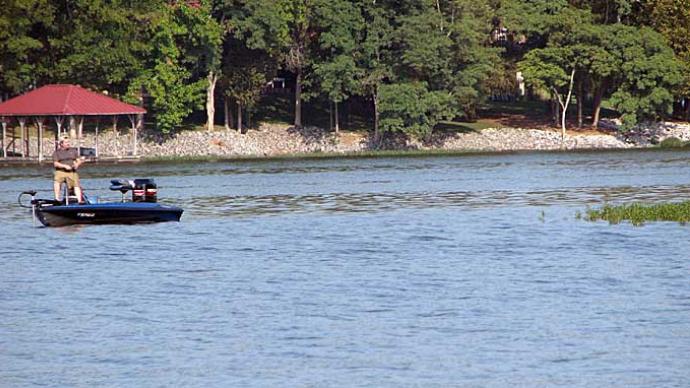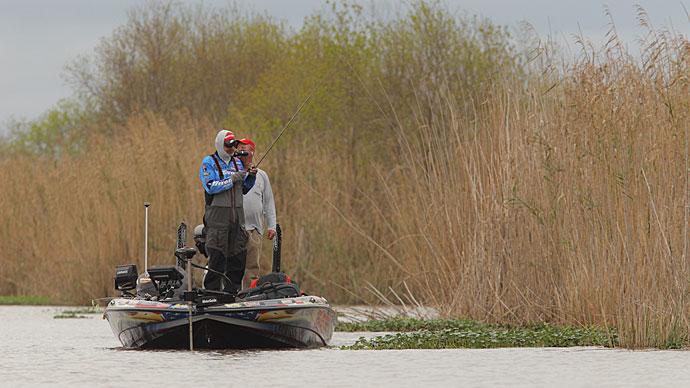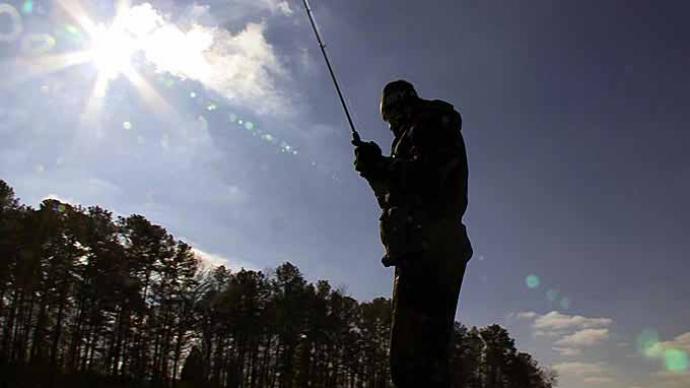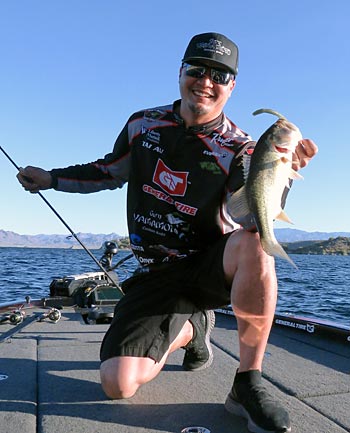
Do you flounder when a storm is on the way or just passing? What about when tournament morning rolls around, and a storm is just starting? Many anglers struggle when a complete change in weather hits the lake, so we asked four pros how they deal with storms and fronts.
The Barometer
Tai Au, a Nitro and Yamamoto Pro from Arizona, says that the concept of basing your fishing on the barometer is easy, but it takes time on the water to perfect. He says it works so well that he swore he’d never agree to do an article on it. Fortunately for us, he broke that promise. He says it’s so important that he decided people need to know about it. Tai has won well over $125,000 by watching the barometer – and it was also vital in his recent win at the FLW Western Division at Havasu.
Says Tai, before it rains, the pressure drops, and the fish get active – everything is active. That means get out the reaction baits. After the storm, however, high pressure and those dreaded “blue-bird skies” make it difficult, with inactive fish and even the birds just sitting around. On days like that, says Au, you need to throw a slow-moving bait like a Yamamoto Hula Grub, a Senko, or a Ned rig. Changes in barometric pressure don’t need to produce a storm to make a big difference, either.
When the pressure drops, he picks up a Yamamoto Zako Swimbait. At Mead, he had two days of practice with clouds and low pressure a couple of years ago. The fishing was phenomenal. But experience told him what was coming, and sure enough, on tournament day, everything had changed. He tried a buzzbait, had four bites in twenty minutes, missed them all, then caught one outside on the trailer hook. So he put everything away, picked up a drop shot, and caught just seven fish that day. Where did the fish go? They were still there; the high pressure meant you had to fish slowly. On the second day, he spotted low clouds off in the distance. He waited for them to get over him, picked up a crankbait, and culled out four times. That’s what a difference barometric pressure makes. He ended up getting second place in that tournament.
Tai says high pressure turns them off, even with a wind. Low pressure turns them on. He watches the barometric pressure with an app. At the Delta, when a low-pressure system moved in, everyone thought “cold front” and slowed down. He knew it was a low-pressure front, stuck with a Chatterbait, and caught tons of fish. He says if you catch fish and a high-pressure front moves in, stay there and slow down. He says that actual numerical changes in the barometer may look small, but it’s the trend you need to note. And watch the clouds – big fluffy clouds signal a low pressure; wispy or no clouds mean high pressure.
During The Storm
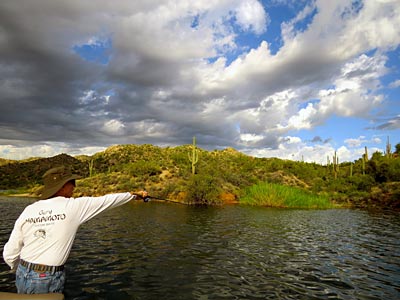
Takahiro Omori says nobody likes to fish in the rain, but sometimes you have to. One thing that heavy clouds affect is the light. It can be like night fishing to fish in a storm or heavy clouds. So Takahiro changes to much brighter colors – like chartreuse or white- so the fish can see his lures. He likes to use shallow-running chartreuse crankbaits, but he also likes topwater baits that make a lot of noise so that the fish can see and hear his baits.
Omori says that in summer, water coming in from a storm can be a good thing because it is usually cooler, but in early spring, it can be cold and muddy, and he stays away from that. An entire creek arm can turn to mud very quickly. However, clear water can be dynamite, like around cliffs and waterfalls. He says you have to take it case by case and make adjustments based on the light and clarity of the water.
The Morning After
We went out with Yamamoto Pro Marty Lawrence the day after a storm and faced those bright skies and high pressure. “The day after is rough,” Marty said, but right before a storm is usually excellent.” He says he has noticed that it doesn’t make as big a difference during the winter, but in the summer, a storm pushing through during a night tournament gets them going if you can brave fishing at night during a storm.
Because he lives in Arizona, he fishes for many night tournaments in the summer, and summer in Arizona means monsoon storms. These storms usually roll in at night, and if you’re out on the water, it can mean that jigs and reaction baits can fill the boat in a hurry. He says a fisherman’s best friend in a storm is a Minnkota Ultrex because it will hold your position all night, even if water is coming over the bow. He has stayed on the water in those conditions – he sets the Ultrex and fishes from the back!
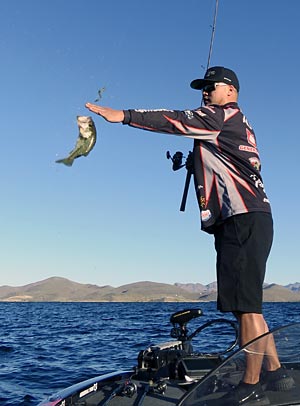
After the storm is a lot different, though; once a storm front has moved through and there is a high-pressure front with clear skies, it’s time to pick up a drop shot or a jig and drag the bottom, says Marty. He says that high pressure tends to make them suspend over something, but they will still eat if you can target their depth.
Before And After
Gary Dobyns, now headquartered in Texas, absolutely loves foul weather. “I’ve had many, many wins in bad weather,” he says, and the fact that rain and wind and low pressure make the fish more aggressive plays right into his style of fishing. In addition to making the fish more active, he says, it also means less light penetration, so the fish don’t get as good a look at the bait.
Gary has always been known as a power fisherman – he likes to put on a reaction bait and hammer away at a lake. His worst year, he says, was the year that he was “fishing chicken” – fishing for a limit instead of going after big fish. That year taught him a lesson. Fishing before a storm is precisely how he likes it – shallow, fast, and bright colors. Wind will stir up a bank, he says, and even a bank that looks like nothing can have big fish all over it. This is the time to grab a big jerkbait, a Chatterbait, spinnerbaits, topwater if it isn’t cold, or even a jig – and cover water. Put the trolling motor on high and have at it, he says.
If the high pressure has been in place for a few days, it isn’t so bad, Gary says, but the first day or two is brutal. He thinks the second day of a high-pressure front is even worse than the first day. It makes him slow down and fish deep, two things he doesn’t like to do. The deeper fish, though, aren’t as affected by the pressure as the shallow fish are, he says. Also, different species react differently. He says spots aren’t nearly as affected by high pressure as largemouth are, especially Florida strain largemouth. Also, desert fish are more affected by pressure than fish in other regions. Bigger fish are harder to catch those first two days as well.
The wind is another thing you must contend with before and after a storm – Gary says don’t fight it, go with it. He says he’s noticed that wind current doesn’t affect fish as a tide or river current does. Also, the wind seems to make the fish bite better. He says he’ll take a 25-mile-an-hour wind over a glass flat any day.
The Angler
One thing to note is that barometric pressure changes affect people more than others. If you take notes when you’re fishing (and you definitely should), you might start adding how you feel that day. Studies have shown that migraines and other kinds of headaches increase on days with even small drops in barometric pressure, and many people notice more joint pain when the weather changes. If you are aware of things like this, you can be prepared by having medication on board. It’s hard to concentrate on fishing when you don’t feel well.
You can’t control the weather, but you can adapt to it. Hit the app store and get a good barometric pressure app, and you’ll have a head’s up on what’s coming. Check it and make notes. The changes are small, but keep track of the trend. When it’s falling, get ready to tie on a crankbait, and when it’s rising, know that you’ll probably have to fish low and slow. Weather can change a bite overnight, but if you know how to react, that’s half the battle.
BassResource may receive a portion of revenues if you make a purchase using a link above.


